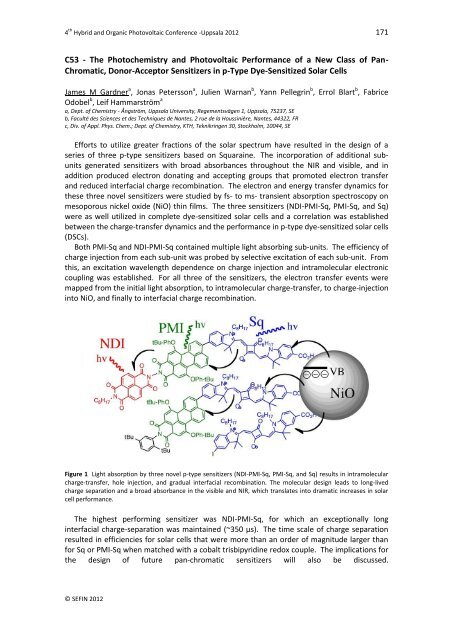HOPV12 - Blogs
HOPV12 - Blogs
HOPV12 - Blogs
You also want an ePaper? Increase the reach of your titles
YUMPU automatically turns print PDFs into web optimized ePapers that Google loves.
4 th Hybrid and Organic Photovoltaic Conference -Uppsala 2012 171<br />
C53 - The Photochemistry and Photovoltaic Performance of a New Class of Pan-<br />
Chromatic, Donor-Acceptor Sensitizers in p-Type Dye-Sensitized Solar Cells<br />
James M Gardner a , Jonas Petersson a , Julien Warnan b , Yann Pellegrin b , Errol Blart b , Fabrice<br />
Odobel b , Leif Hammarström a<br />
a, Dept. of Chemistry - Ångström, Uppsala University, Regementsvägen 1, Uppsala, 75237, SE<br />
b, Faculté des Sciences et des Techniques de Nantes, 2 rue de la Houssinière, Nantes, 44322, FR<br />
c, Div. of Appl. Phys. Chem.; Dept. of Chemistry, KTH, Teknikringen 30, Stockholm, 10044, SE<br />
Efforts to utilize greater fractions of the solar spectrum have resulted in the design of a<br />
series of three p-type sensitizers based on Squaraine. The incorporation of additional subunits<br />
generated sensitizers with broad absorbances throughout the NIR and visible, and in<br />
addition produced electron donating and accepting groups that promoted electron transfer<br />
and reduced interfacial charge recombination. The electron and energy transfer dynamics for<br />
these three novel sensitizers were studied by fs- to ms- transient absorption spectroscopy on<br />
mesoporous nickel oxide (NiO) thin films. The three sensitizers (NDI-PMI-Sq, PMI-Sq, and Sq)<br />
were as well utilized in complete dye-sensitized solar cells and a correlation was established<br />
between the charge-transfer dynamics and the performance in p-type dye-sensitized solar cells<br />
(DSCs).<br />
Both PMI-Sq and NDI-PMI-Sq contained multiple light absorbing sub-units. The efficiency of<br />
charge injection from each sub-unit was probed by selective excitation of each sub-unit. From<br />
this, an excitation wavelength dependence on charge injection and intramolecular electronic<br />
coupling was established. For all three of the sensitizers, the electron transfer events were<br />
mapped from the initial light absorption, to intramolecular charge-transfer, to charge-injection<br />
into NiO, and finally to interfacial charge recombination.<br />
Figure 1 Light absorption by three novel p-type sensitizers (NDI-PMI-Sq, PMI-Sq, and Sq) results in intramolecular<br />
charge-transfer, hole injection, and gradual interfacial recombination. The molecular design leads to long-lived<br />
charge separation and a broad absorbance in the visible and NIR, which translates into dramatic increases in solar<br />
cell performance.<br />
The highest performing sensitizer was NDI-PMI-Sq, for which an exceptionally long<br />
interfacial charge-separation was maintained (~350 μs). The time scale of charge separation<br />
resulted in efficiencies for solar cells that were more than an order of magnitude larger than<br />
for Sq or PMI-Sq when matched with a cobalt trisbipyridine redox couple. The implications for<br />
the design of future pan-chromatic sensitizers will also be discussed.<br />
© SEFIN 2012


